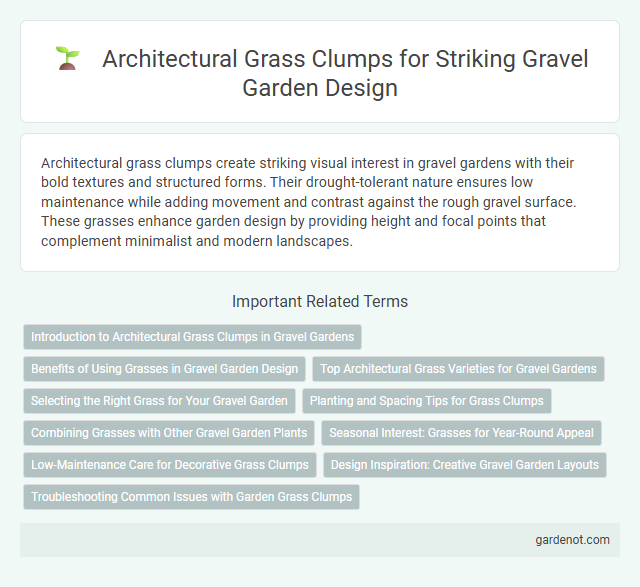Architectural grass clumps create striking visual interest in gravel gardens with their bold textures and structured forms. Their drought-tolerant nature ensures low maintenance while adding movement and contrast against the rough gravel surface. These grasses enhance garden design by providing height and focal points that complement minimalist and modern landscapes.
Introduction to Architectural Grass Clumps in Gravel Gardens
Architectural grass clumps in gravel gardens provide striking textures and vertical interest while enhancing drought tolerance. Species such as Miscanthus sinensis and Pennisetum alopecuroides thrive in well-drained gravel beds, creating natural focal points with low maintenance requirements. Their foliage and seed heads catch light beautifully, contributing seasonal movement and structural definition to minimalist garden designs.
Benefits of Using Grasses in Gravel Garden Design
Architectural grass clumps enhance gravel garden design by adding texture, movement, and year-round interest, creating a dynamic focal point in minimalist landscapes. Their drought tolerance and low maintenance requirements make them ideal for sustainable gardening, reducing water usage while maintaining visual appeal. Grasses also improve soil stability and help suppress weeds in gravel beds, contributing to an eco-friendly and resilient garden environment.
Top Architectural Grass Varieties for Gravel Gardens
Top architectural grass varieties for gravel gardens include Miscanthus sinensis, Pennisetum alopecuroides, and Festuca glauca, known for their striking form and texture. These clumping grasses provide year-round structure, drought tolerance, and minimal maintenance, enhancing the minimalist aesthetic of gravel landscapes. Their upright growth habit and ornamental seed heads create dynamic movement and visual interest in gravel garden designs.
Selecting the Right Grass for Your Gravel Garden
Choosing the right architectural grass for your gravel garden involves prioritizing species with minimal root spread and drought tolerance, such as Festuca glauca or Carex buchananii. Look for grasses with strong structural forms and contrasting textures to create visual interest and complement the gravel's coarse surface. Opting for low-maintenance, slow-growing varieties ensures longevity and reduces upkeep in the gravel garden environment.
Planting and Spacing Tips for Grass Clumps
Plant architectural grass clumps with a spacing of 18 to 24 inches to allow for healthy growth and airflow, preventing disease and promoting a clean, structured look in a gravel garden. Choose varieties like Muhlenbergia or Carex that achieve defined clump shapes and complement the gravel's texture. Incorporate mulch around the base to retain moisture and suppress weeds, enhancing the overall durability and aesthetic appeal of the planting.
Combining Grasses with Other Gravel Garden Plants
Architectural grass clumps such as Miscanthus sinensis and Pennisetum alopecuroides create striking vertical structure in gravel gardens when combined with low-growing succulents and flowering perennials like Sedum and Lavender. These grasses' texture and movement contrast beautifully with the static, sculptural forms of drought-tolerant plants, enhancing visual interest and biodiversity. Grouping grasses with deep-rooted shrubs such as rosemary or ornamental thyme also improves soil stability and resilience in arid, gravelly conditions.
Seasonal Interest: Grasses for Year-Round Appeal
Architectural grass clumps create striking vertical accents in a gravel garden, offering dynamic movement and texture throughout the year. Varieties such as Miscanthus sinensis and Pennisetum alopecuroides exhibit vibrant autumn colors and feathery seed heads, maintaining interest even in winter. Their drought tolerance and low maintenance requirements make them ideal for sustainable landscaping with consistent seasonal appeal.
Low-Maintenance Care for Decorative Grass Clumps
Architectural grass clumps such as Miscanthus sinensis and Festuca glauca thrive in gravel gardens due to their drought tolerance and minimal water requirements. These decorative grasses require infrequent pruning, typically once a year in late winter to remove dead foliage and stimulate healthy new growth. Low-maintenance care combined with excellent soil drainage in gravel beds ensures long-lasting plant vigor and aesthetic appeal throughout the seasons.
Design Inspiration: Creative Gravel Garden Layouts
Architectural grass clumps create striking visual interest in gravel garden layouts by combining textures and forms that contrast the hardscape with soft, flowing foliage. Incorporating species like Miscanthus or Pennisetum in strategic clusters enhances depth and movement, emphasizing naturalistic design principles within contemporary outdoor spaces. These grass groupings also improve sustainability by requiring minimal maintenance and efficiently stabilizing gravel surfaces through their root systems.
Troubleshooting Common Issues with Garden Grass Clumps
Architectural grass clumps in gravel gardens often face issues such as poor drainage, leading to root rot or fungal diseases. Ensuring proper soil aeration and using well-draining gravel can prevent waterlogging and promote healthy growth. Regularly trimming dead foliage and monitoring for pests like aphids or mites help maintain the aesthetic and vigor of garden grass clumps.
Architectural grass clump Infographic

 gardenot.com
gardenot.com